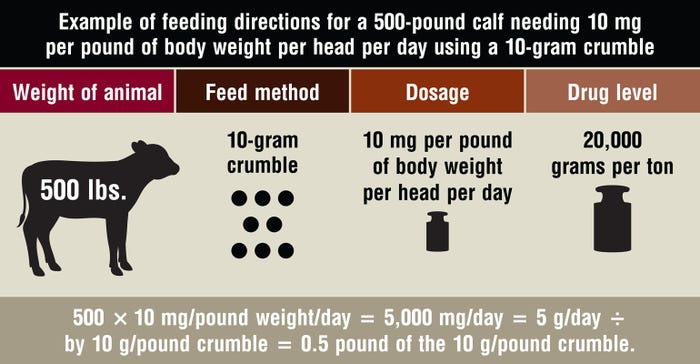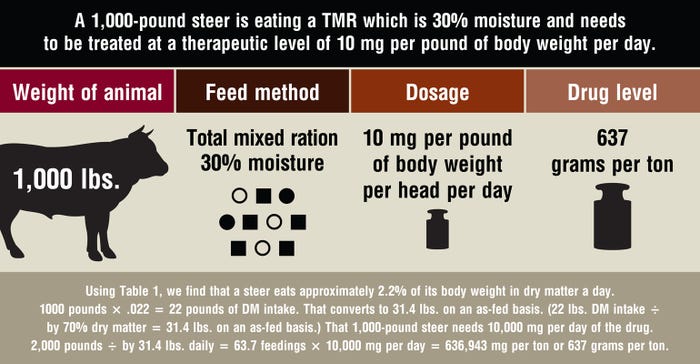How to correctly calculate grams per ton of drugs in feed for your VFD
Need to fill out a Veterinary Feed Directive form and don’t know what to put down for grams per ton? Here’s how to correctly calculate grams per ton of drugs in feed.
July 13, 2017

By Ralph D. Wilson
Now, more than ever before, the veterinarian, the producer and the feed supplier must communicate and work together. When all parties work in concert, the Veterinary Feed Directive (VFD) is much easier and more likely correct.
When the veterinarian is left to assume/guess the method of feeding, the drug level is data left to interpretation and judgement as to correctness by an outside inspector. This is a major point to cause a veterinarian concern and give him/her cause to prefer alternative treatment methods where he/she knows exactly how treatment is going to be done.
A great deal of information is required to have precise estimates of the modifiers of feed, and hence drug intake, when correctly filling out the VFD form. A stumbling block in the effort to fill out the forms correctly is the space for listing the drug level as grams per ton (g/T) of drug, especially for cattle, as there are so many feeding methods to accomplish the proper dosage.
That’s why meeting the VFD challenge calls for an integrated, close relationship between the producer, veterinarian and the feed supplier. An incorrect VFD form given to a feed supplier should stop the whole treatment process and require an urgent call to the veterinarian on record.
The proper dosage should be paramount in our efforts to treat animals in our care. Under-dosing of a drug could result in improper treatment, continued sickness and even death of the patient. Over-dosing of drugs is irresponsible and could lead to residue in the food we are producing. FDA Guidance for Industry 233 states that the VFD form will have a space for veterinarian to populate with the drug level in the feed in grams per ton.
However, the veterinarian has a very difficult time in filling out the drug level portion of the VFD form, mostly because he/she is working with insufficient information from the producer and feed supplier. The VFD is much easier when the veterinarian is working in concert with the producer and feed supplier.
In the process of establishing the veterinary-client-patient-relationship (VCPR), communication often lacks as to the feeding method that will be used. It must be known whether the producer uses a Type B crumble or a Type A medicated feed article (MFA) in a total mixed ration (TMR).
The VFD form only calls for the estimated number of animals, but the veterinarian must also know the weight of the animals and the preferred feeding method. Is the drug included in a protein concentrate to be fed at a pound per head per day along with ad libitum access to a hay/silage mixture or is it in a TMR of which the moisture of the mix is unknown to the veterinarian?
The modifiers of intake are impossible to know without a great deal of prior information from all concerned. The producer, feed supplier and his nutritionist must help the veterinarian with all this information, or the intakes will be based solely on generalized assumptions.
Modifiers of intake include moisture content, forage/grain quality, energy density, sex, stage of production, age, temperature, bunker/feeder space, genetics, number of feedings, access to water, feeder adjustment and activity, just to name a few. If these factors are known beforehand and are of sufficient magnitude, they must be included in the calculations going into g/T.
Examples with cattle
While there are examples in swine and chickens, this author is not aware of any drug label claims of VFD drugs where the dosage for cattle is indicated in grams per ton. The reason for this is drug sponsors did not conduct the claim-proving trials in an ad libitum feeding manner, but conducted the experiments with known dosage of milligrams per head or milligrams per unit of body weight.
Editor's Note--It has come to our attention that there are products with a grams per ton label. For instance, both Tylan and Pulmotil, marketed by Elanco, have grams per ton on the label.
Thus, the labels all list the required dosage and generally have tables of example g/T based on intakes or feeding methods. Common label dosage recommendations are 70 mg per head per day, 350 mg per head per day or 10 mg per pound of bodyweight per head per day, as examples. While the dosages may be somewhat common, the methods of feeding in cattle are considerably varied.
Using crumbles
Irrespective of the feeding method or dosing rate, using a crumble requires the g/T on the VFD form to match the crumble potency.
A 2 gram per pound crumble will have a drug level on the VFD of 4,000 grams per ton (2g X 2,000 pounds = 4,000 g/T)
A 10 gram per pound crumble will have a drug level on the VFD form of 20,000 grams per ton (10g X 2,000 pounds = 20,000 g/T)

Hopefully there are a large number of head in the pen so that a reasonable quantity can be weighed and fed to the pen. In this example, calf weight did not matter. Additionally, if a small number of cattle are in the pen, then a 2 gram crumble would make more practical sense. (350mg/head/day divided by 2,000mg/lb = 0.175lb of 2g crumbles.)

In both cases above, the grams per ton on the VFD form would read 20,000g/T if a 10 gram per pound crumble was used in drug delivery, irrespective of the weight of the beast or the claim indicated. However, yes, the feeding directions would change.
Using a 0.5 pound per head per day protein concentrate
When using a medicated concentrate or base mix to feed the cattle, the feeding rate of the concentrate and dosage are paramount. In this case of an intended feeding rate of a half-pound per head per day, the dosage must be supplied in that half-pound of base mix.

The VFD in this case would read 1,400 grams in the grams per ton space and the feeding directions would read feed 0.5lb per head per day to achieve 350 mg per head per day dosage.

The VFD in this case would read 20,000 g/ton and the feeding directions would read feed 0.5 pound per head per day to achieve 5,000mg per head per day or 5 grams per head per day.

The VFD would read 1,800 grams of protein/grain mix to be fed at the rate of 10 pounds per head to achieve 9,000 mg per head per day.
In a total mixed ration (TMR), the weight of the beast and the intake come into the calculations.
How much do cattle eat daily? That depends. The rule of thumb is 2% of bodyweight of dry matter intake per day. Rule of thumb – a 400 pound calf eats 8 pounds of dry matter; a 1200 pound heifer eats 24 pounds of dry matter. The underlying trouble is cattle rarely eat according to the rule of thumb. It fits big cattle much better than younger, lighter cattle.
Modifiers of intake for cows often taken into account are the quality of forage and stage of production. References state that when forage quality is low (52% TDN or less) (TDN =total digestible nutrients) and cows are not lactating, they will consume 1.8% and lactating cows about 2.0% of their weight on a dry matter basis.
If the forage quality is average (TDN content between 52% and 59%), non-lactating cows will consume about 2.0% to 2.1% and lactating cows about 2.3% of their bodyweight daily on a dry matter basis. Just so this isn’t a source of more confusion, examples of low quality forage are corn stubble, wheat/oat straw or stalky, mature grass hay. Higher TDN forage is categorized as quality hay, alfalfa or ear chop.
Growing cattle are a different matter as age is confounded with weight. A 400-lb. calf on a grower ration will eat at 3% of body weight on a dry matter basis, while a 750-lb. steer will eat a grower/developer ration at 2.5% of body weight on a dry matter basis. Then too, a 1000-lb. critter on finishing diet takes in closer to 2% of bodyweight on a dry matter basis (Table 1).

Cattle diets vary in the dry matter content depending upon the moisture level of the feedstuffs. Going to extremes, the dry matter of a diet based on wheat straw is dramatically different than one based on corn silage. Grains are rather typically 12% moisture or 88% dry matter.
One would use the dry matter percentage to convert the intake of grain from dry matter basis to as-fed basis. If the animal was predicted to eat 10 pounds of grain on a dry matter basis, it would be 11.36 pounds (10 / 0.88 = 11.36) on an as-fed basis.
The dry matter/as-fed intake switch on the Global Vet Link (GVL) forms is not there for a source of confusion. It is intended to be an aid to those who are aware that cattle intake calculations start as dry matter intakes and then are converted to compensate for the moisture level of the diet. The uninitiated try to make this a bottleneck. The recipe is actually rather simple.
Another factor in this discussion is that the drug claims and dosages were all applied for and proven by the drug sponsors on an as-fed basis.
Let’s try an example:

Or, alternatively, 350 mg per head per day / 14.12 pounds feed = 24.8 mg per pound or 49.6 grams per ton as-fed feed
The only way that a veterinarian could have any chance of calculating and properly filling the drug level space on a VFD would be with the aid of the producer, feed supplier and/or nutritionist, when the feeding method is a TMR. If a veterinarian is filling out a VFD form with insufficient knowledge of intake modifiers like dry matter of the diet, then assumptions will have to be made and should be listed on the VFD form Special Instructions section.
Another dry matter example

In this case, the VFD would be populated with 637 grams per ton with feeding directions that the 1000-pound steers were to be fed the TMR at 31.4l pounds to obtain 10 mg per p9ound of body weight per day. The 70% DM could be added for good measure.
Filling the space on VFD forms with the proper grams per ton is not an insurmountable task. Far from it. However, make no mistake, it becomes an easier task when information from all parties—the veterinarian, the producer and the feed supplier—work together to improve the accuracy of the data and strengthen the veterinary-client-patient relationship.
Ralph D. Wilson, Ph.D., is director of sales for Pharmgate Animal Health, Wilmington, N.C. Previously he was the Midwest regional manager for PennField Animal Health and swine nutritionist with Standard Nutrition. He has served as the Colorado State Extension swine specialist and a North Carolina area swine specialist. Along with his father, Frank L. Wilson, Ralph grew up finishing hogs on operations in southern Kansas.
You May Also Like


.png?width=300&auto=webp&quality=80&disable=upscale)
